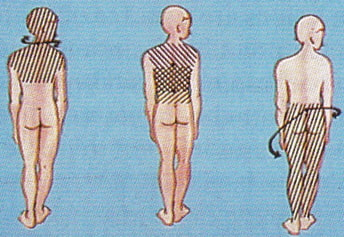Pain from mechanical irritation of the lumbar dural sac

Loss of normal locomotor system equilibrium can chronically stretch, torsion, deform or drag the tissue of the dural sac, compromising its ability to withstand normal postural movement. It can resist chronic irritation extremely well up to a point, then it becomes hypersensitive and a pain generator. The dural sac is commonly irritated and distorted near either end, the neck or pelvis/coccyx, from traumatic events such as whiplash type injuries, a fall or repetitive habits such as sleeping prone or poor posture while sitting. Degenerative conditions of the spine such as osteoarthritis, spondylosis, disc bulge, protrusions or hernias are also common causes of local irritation throughout the spine. These aberrant stresses manifest themselves neurologically as muscle pain or other symptoms, in the head, shoulders, arms, hips or legs and are often clinically misinterpreted as being a local problem at the site of pain, while in reality the cause of pain is at the spine.
At the cranial cervical junction, when locomotor equilibrium is compromised mechanical function is impaired. This can chronically irritate the dural membrane and reflexively cause tension in the sub occipital muscles. It has been estimated that more than 80% of headaches are related to "stress" both physical (poor posture, lack of locomotor equilibrium, etc.) and psychological (the various preoccupations of everyday life). Regardless of the type of stress involved, the interplay of various factors leading to the onset of headaches are quite common. Several of the nerves that come out of the upper cervical spine travel up over the occiput. When the sub occipital muscles become irritated because of postural fatigue or mental stress, they chronically contract, irritating the nerves that pass through them. The sub occipital is a common area of dural sac irritation as well as a key area of nerve irritation that leads to headaches. But, if irritation occurs a little lower down the cervical spine, you can experience pain in the shoulder, arm or upper back.
At the other end of the spine, the dural sac attaches to the sacrum and coccyx. The loss of the normal locomotor equilibrium caused by trauma, from modern sedentary habits (sitting too long in the car, office or at home) or degenerative spinal conditions can irritate the lumbar dural sac resulting in pain in the back, or hip, or in the leg. Regardless of where the point of irritation is located symptoms can be very distant. As an example, strange as it seems, too much dural tension at the level of the coccyx can cause headaches.
The precise dynamic relationship between the dural sac and other locomotive tissues must be considered, examined and treated as necessary. The lack of proper evaluation and treatment of any compromised tissue reduces the chance of successful recovery from symptoms caused by irritation or injury.
At the cranial cervical junction, when locomotor equilibrium is compromised mechanical function is impaired. This can chronically irritate the dural membrane and reflexively cause tension in the sub occipital muscles. It has been estimated that more than 80% of headaches are related to "stress" both physical (poor posture, lack of locomotor equilibrium, etc.) and psychological (the various preoccupations of everyday life). Regardless of the type of stress involved, the interplay of various factors leading to the onset of headaches are quite common. Several of the nerves that come out of the upper cervical spine travel up over the occiput. When the sub occipital muscles become irritated because of postural fatigue or mental stress, they chronically contract, irritating the nerves that pass through them. The sub occipital is a common area of dural sac irritation as well as a key area of nerve irritation that leads to headaches. But, if irritation occurs a little lower down the cervical spine, you can experience pain in the shoulder, arm or upper back.
At the other end of the spine, the dural sac attaches to the sacrum and coccyx. The loss of the normal locomotor equilibrium caused by trauma, from modern sedentary habits (sitting too long in the car, office or at home) or degenerative spinal conditions can irritate the lumbar dural sac resulting in pain in the back, or hip, or in the leg. Regardless of where the point of irritation is located symptoms can be very distant. As an example, strange as it seems, too much dural tension at the level of the coccyx can cause headaches.
The precise dynamic relationship between the dural sac and other locomotive tissues must be considered, examined and treated as necessary. The lack of proper evaluation and treatment of any compromised tissue reduces the chance of successful recovery from symptoms caused by irritation or injury.